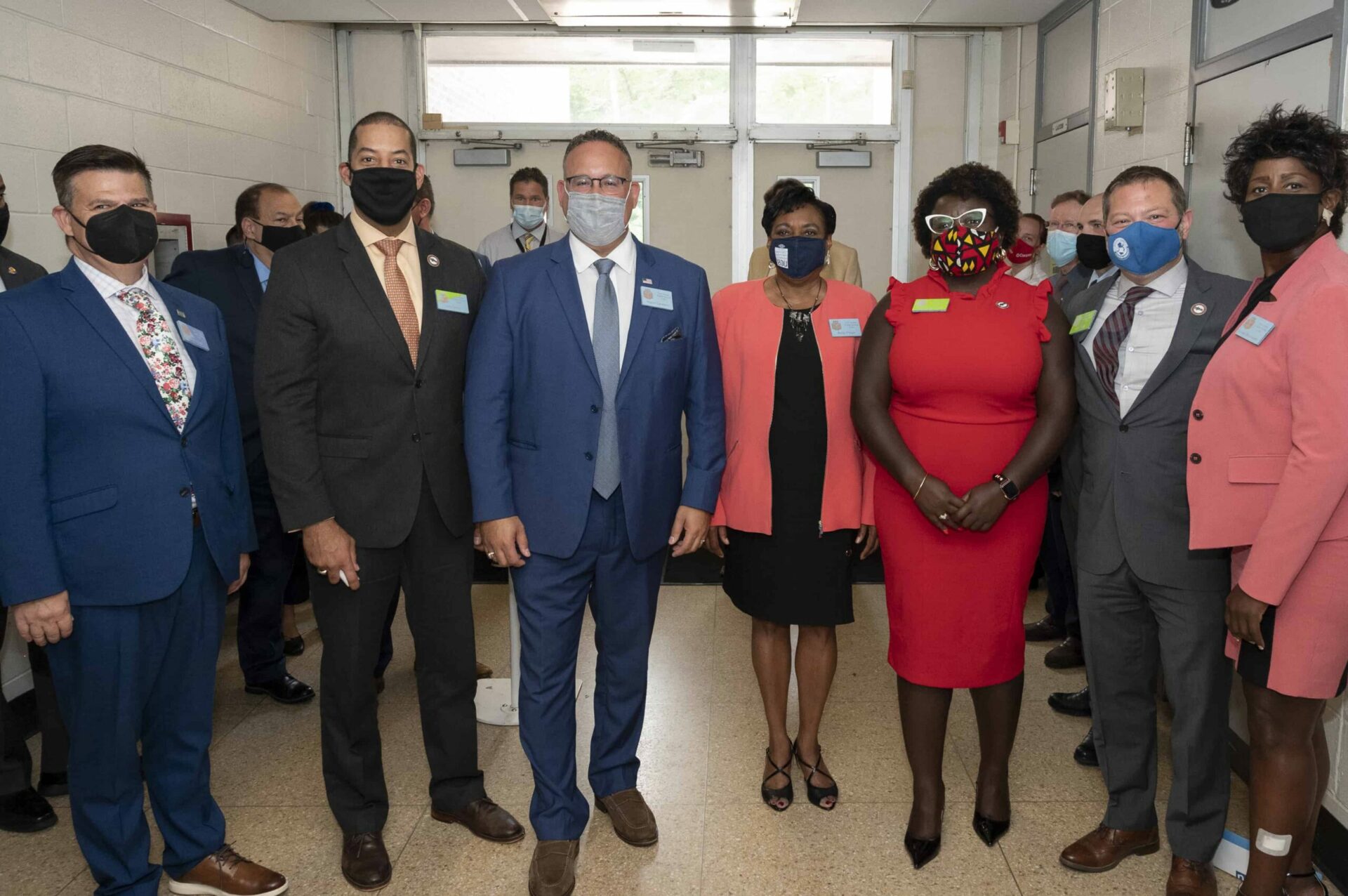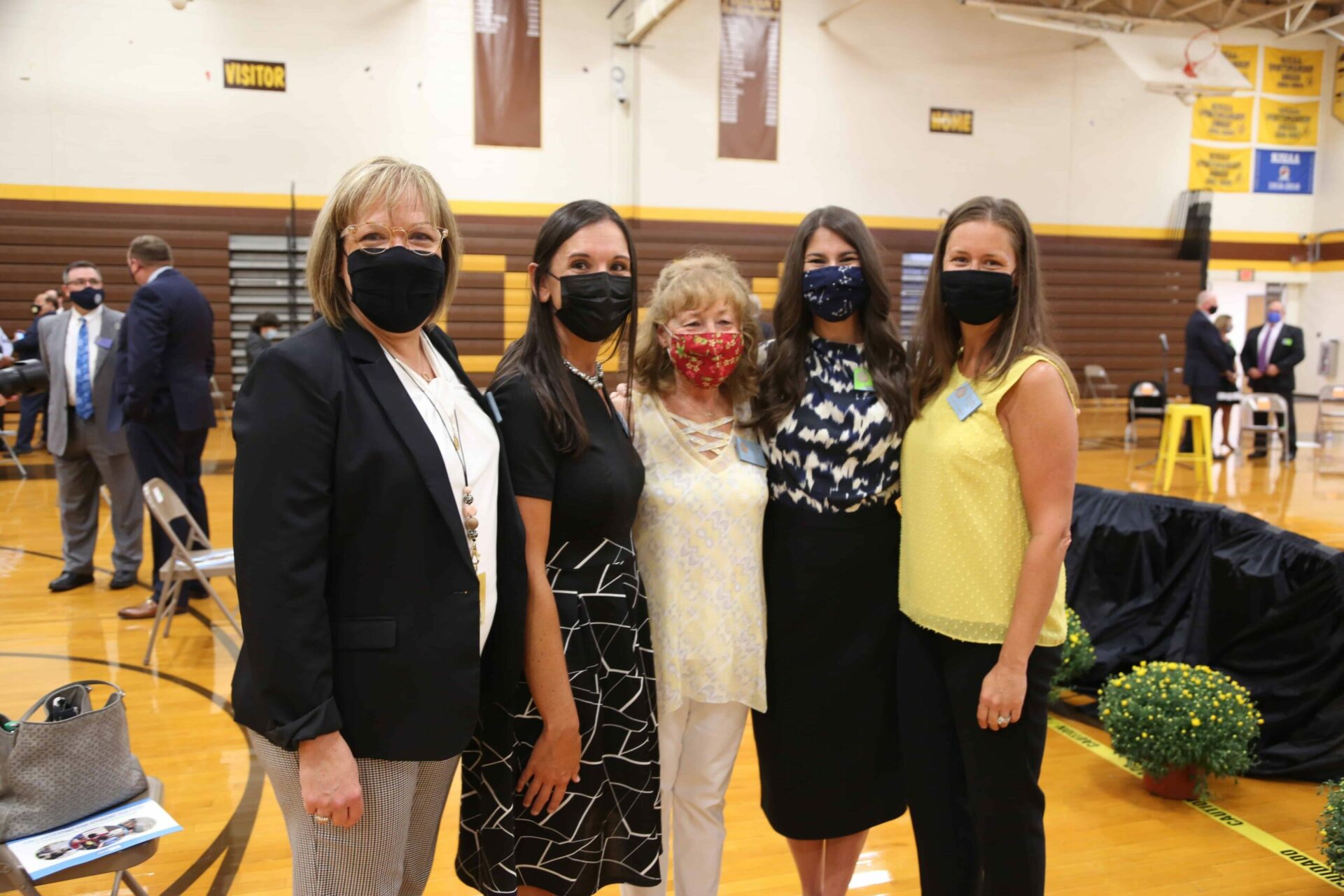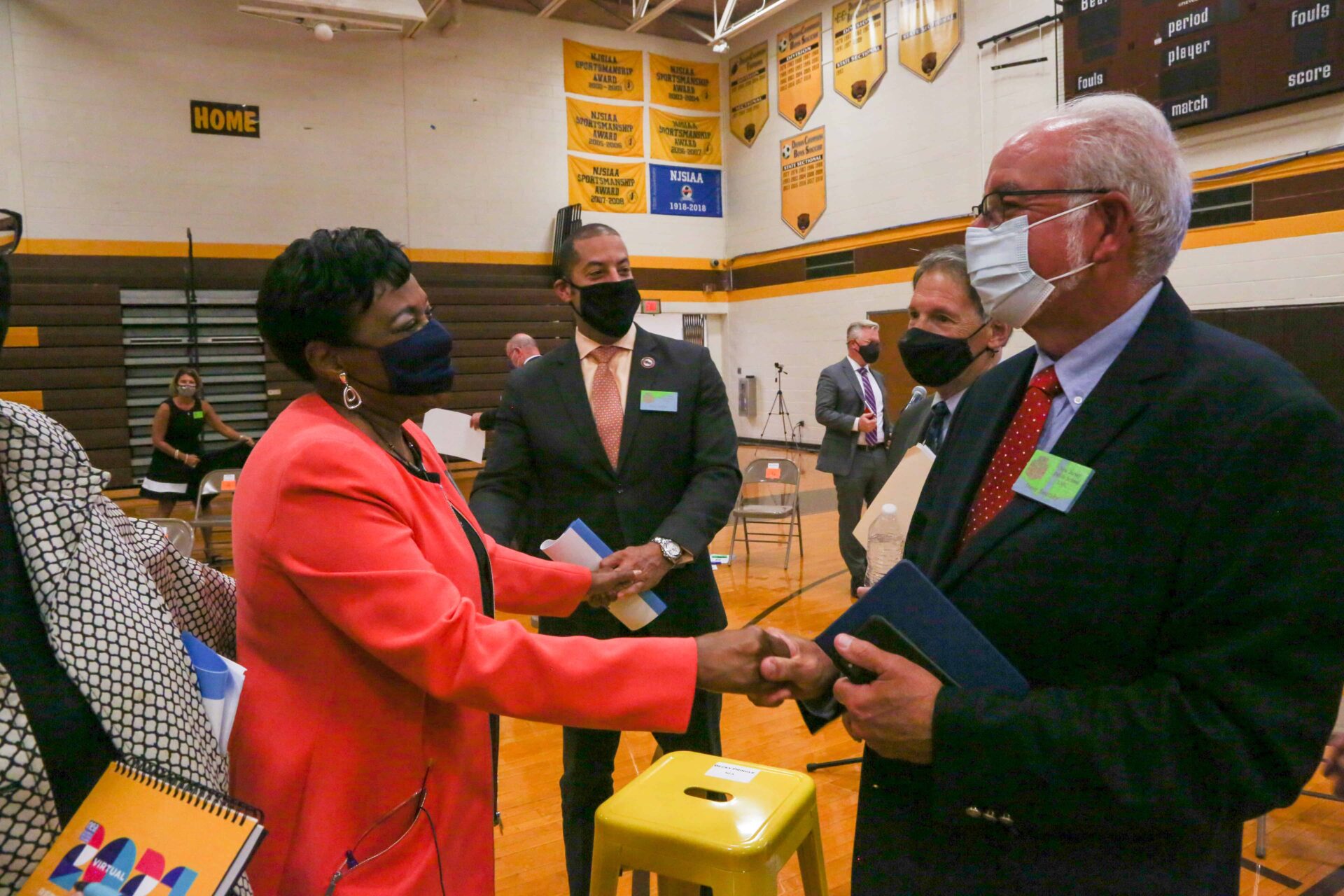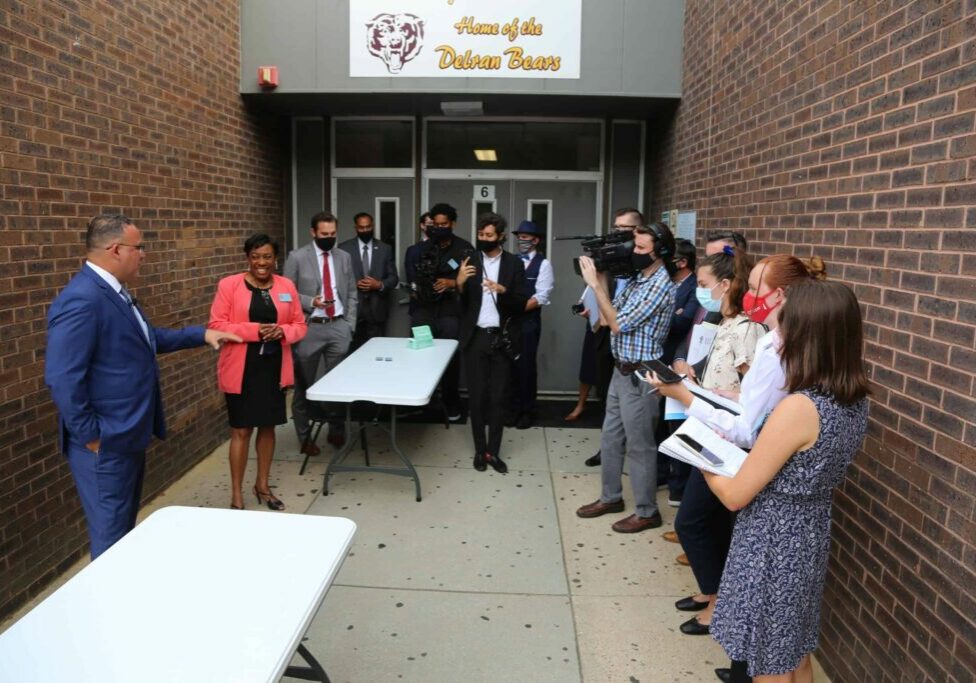New Jersey Public School Labor-Management Collaborative gets national attention
By Patrick Rumaker, NJEA Review editor
U.S. Secretary of Education Miguel Cardona and NEA President Becky Pringle visited Delran High School in Burlington County on Sept. 8 for a closer look at a program they hope will take root nationwide. Delran Superintendent Dr. Brian Brotschul and Delran Education Association (DEA) Secretary Kathleen McHugh led a socially distanced panel discussion to present their experience as part of the New Jersey Public School Labor-Management Collaborative (NJPSLMC).
Demonstrating the breadth of that collaboration, the panel consisted of DEA leaders and Delran Public Schools administrators and school board members, and leaders from statewide education stakeholder groups including NJEA, the New Jersey School Boards Association, the New Jersey Principals and Supervisors Association, and the New Jersey Association of School Administrators.
Saul Rubinstein, a professor in the Rutgers School of Management and Labor Relations who coordinates the state’s collaborative, also spoke on the panel.
“What better way to discuss the potential of our country’s education system than to find systems that do it well together,” Cardona said. “The work that you are doing to collaborate, to engage with partners to pursue success is being noticed, and we want to replicate it because we know it works.”
Pringle said that she had urged Cardona to come to Delran to see the program, insisting that what is happening in the New Jersey’s collaborative program, as exemplified in this South Jersey community, can be brought to scale nationwide. She emphasized the value of labor management collaboratives for student achievement and for building a culture of equity in schools for children and adults.
“When adults in the system work together, we can be worthy of our children,” Pringle said.
But NEA is doing much more than showcasing the program to the U.S. secretary of education. NEA has provided NJEA with a $500,000 grant to help expand the NJPSLMC in New Jersey and is offering additional funds to help other interested state and local associations across the nation plan and launch partnerships that foster labor-management collaboration practices in districts and worksites. NEA has committed to invest more than $3 million over three years to fund and grow the initiative.

Credit: Savaria Photography
Educator voice and student achievement
Prior to the panel, DEA President Amy Yodis explained that Delran is in its sixth year participating in the NJPSLMC. Over the course of those six years, and especially in the last three years, they have figured out what works best for Delran, she said.
“We’re seeing increased student achievement and people on the front lines are really feeling valued and that their voice matters,” Yodis said.
In Delran, leadership teams in each school meet monthly. A district-level team also meets monthly. McHugh explained that DEA members voices have had a direct impact on the district at a practical level.
“We’ve had a lot of voice with professional development, for rollout of curricula, and we’ve been able to be very intentional with what happens across grade spans—what makes an initiative a success with pre-k to second grade versus what makes an initiative successful in middle or high school,” McHugh said. “We’ve been able to set up lab sites and pilots for things before we dig in and invest as a district—whether it be a new curriculum or something of that nature.”
McHugh noted that the school leadership and district leadership teams have been able to look at the “collateral impact” of decisions so that they can ensure that members’ and students’ needs are being met. She said the collaboration enables schools to remove obstacles to teaching and learning that might not otherwise be easily noticed when the voices of teachers and educational support professionals are not put at the center of decision-making.
McHugh explained the roles of the school-level teams and the district-level team.
“The goal for the school teams is to be very independent decisionmakers for what works in their schools—they look at what their opportunities are, their goals for improvement and what that looks like for their particular school,” McHugh said. “The district level team looks at ways to support the school teams. And the district leadership team is also looking at those umbrella issues that impact everyone.”
Yodis added that each school leadership team may have the same processes, but each one works somewhat differently depending on what works best for them.
During the last two years, as the COVID-19 pandemic became the focus, Delran’s participation in collaborative processes gave the association and the district a head-start in its response.
“The structures were already there, the trust and relationships were already there, the transparency was already there, and that whole philosophy of being committed to each other’s success was there,” McHugh said. “We were committed to the success of our administrative team in that process, and they were on board to ensure that our association was successful—they positioned our leadership and our members to succeed for each of the things that we had to navigate during COVID.”
McHugh is quick to add that it was still a stressful year, but that the structures that existed through the labor management collaborative enabled the association and district to communicate effectively, troubleshoot concerns and have a unified message. She hopes that as the schools move into another year affected by COVID, the collaborative teams can move to a focus on academics rather than the operations focus required to respond to the pandemic.
“We have a real commitment to in-person instruction and our membership knows that their voice is being represented and heard,” McHugh said.
Is it good for kids?
As the formal panel began, Superintendent Dr. Brian Brotschul pointed out that in addition to the association members and administrators, the Delran Board of Education is part of the collaborative process.
“What we do on the front lines in our classrooms and in our schools has direct and immediate synergy in the way that the board functions,” Brotschul said. “And the board asked me one question about this process, the same one we administrators asked each other: ‘Is it good for kids?’ And I’ll tell you, collaboration is good for kids—today you’re going to hear about how great it’s been on the achievement side and how great it’s been on the side of a culture of collaboration.”
Brotschul introduced Rubinstein to provide the data showing the benefit to students when collaboration among the adults in school buildings and school districts is intentional and sustainable. Rubinstein has helped coordinate the state’s collaborative, and with John McCarthy of Cornell University, has conducted research that reveals the positive impact of greater collaboration.
Rubinstein framed the “why” of partnerships between educator unions and administrations and school boards and what those partnerships mean in terms of student achievement and what they mean for teachers and staff.
“We live in a democracy, and in a democracy it’s important that all stakeholders have a voice,” Rubinstein said. “That means teachers, that means staff, that means administration, that means school boards, that means parents, that means students. This work is about giving voice to all the stakeholders in a democracy.”
The other question, he said, is whether such partnerships benefit students and teaching and learning.
Rubinstein presented three conclusions from a 2017 study of 450 schools across six states that included over 5,000 educators. The schools were surveyed to determine the level of collaboration among faculty and staff and administrators. The survey tracked student achievement on standardized tests. The study was controlled to balance out factors such as poverty to isolate the impact of collaboration among staff and administrators.
The study found that in schools where the level of collaboration was high an additional 12.5% of students tested at or above standards in language arts. For math scores, an additional 4.5% of students performed at or above standards in schools with higher collaboration.
The study further found that when collaboration is low, teacher retention is 3.5 times lower in high-poverty schools than in low-poverty schools. But when collaboration is high, there is no statistical difference in teacher retention between high-poverty and low-poverty schools.
Through other studies conducted in 2011, 2012 and 2014, Rubinstein and McCarthy have found that formal labor-management partnerships help improve student performance, lead to more extensive communication between educators, more frequent informal communication between union representatives and school principals, and enhance learning among schools leading to the adoption of innovation from one school to another.
A shift to a collaborative culture
Labor management collaboration is more than just a matter of getting together and talking. It requires intentional practices to sustain it. Speaking on the panel, McHugh noted that after about a year of enthusiastic participation with the foundational concepts of labor management collaboration, the Delran teams hit a plateau.
“Our association leadership and our district leadership came together and said, ‘it’s very important for us to have integrity in this work, and we need support from NJEA to help us over a little bit of a hump to establish structures and processes that could guide this work.’”
Assistance from NJEA, Rubinstein and other partners outside the district enabled DEA and administrators to build capacity in its schools—and even in their hallways—for a shift to a collaborative culture.
“When we first began with labor management collaboration, it was a collection of knowledge and learning how to do something, just like we do in our classrooms,” said panelist and elementary school teacher Tracey McGonigle. “Since then, we’ve been able to apply so much of what we’ve learned. We’ve become more of a culture rather than thinking of this as a strategy to ‘practice’ every day. The capacity that we’ve built upon we can see in more and more individuals across the building from our secretaries, the administration, teachers, even the students are starting to use the same language that we use—that shared language. The way that we operate on a daily basis has changed.”
Michael McHale, principal of Delran Middle School, noted that labor management collaboration had a practical impact on schedules in his building. He said that on the surface it appeared that teachers had time in the schedule for common planning and collaboration with teams of teachers on each grade level. But in reality, others, such as special education teachers, were left out. Labor management collaboration led to the creation of a new master schedule to address the realities of staff schedules.
“The process is just as important as the product, and Mike’s experience at the middle school illustrates that,” Brotschul said. “We’re really focusing on being intentional about every little nuance, and those nuances are informed by the front lines.”
Delran Intermediate School Principal Kimberly Clark-Hickson noted that labor management collaborative practices stress that she is not expected to have the answer to everything.
“The collaborative team that we have really provides a perspective that looks at what our students need—not only academically but also socially and emotionally,” Clark-Hickson said. “And it’s not just our certificated staff. It is everyone in the building. We value all of our voices.”
McHugh agrees.
“When we get together one of the questions that we always ask is, ‘Who should be at the table? What lenses are missing?” McHugh said. “Because there is value in every viewpoint—whether a custodian, a secretary, a paraprofessional, a teacher.”

Statewide support for district collaboration
Rubinstein asked the representatives from the statewide education stakeholder organizations to offer a headline that would tell the members of their individual associations the benefits of labor management collaboration.
“What I’m hearing today are the same messages telling me that every school board member—all 6,000 members here in this state—would benefit from this process,” said Vincent DeLucia, director/educator in residence at the New Jersey School Boards Association. “Some of those things we talk about are climate, culture, equity, social-emotional learning, relationships, and achievement for all kids and adults. That really is the foundation of the work that is happening here.”
DeLucia noted that the statewide steering committee for the NJPSLMC decided that it would model the behaviors and practices that they hope district and school level labor management teams would practice.
“We participate because we get better decisions with people who have the experience and perspective that those of us with titles might not have,” said Mark Stanwood, director of the New Jersey Association of School Administrators Residency Program. “The titles of superintendent, assistant superintendent, directors, principals—those folks with ranks and titles—can’t make the quality of decisions that we can when we ask others who are close to the challenges at hand.”
“It takes a village, and the village likes to talk,” said Karen Bingert, executive director of the New Jersey Principals and Supervisors Association. “Part of the benefit of the collaborative is recognizing that it is the investment of everyone in the space to accomplish what needs to be done. When it comes to the talking part of it, talk can be really negative and undermine a goal, or you can channel that energy so that the village is actually getting something accomplished.”
Bingert offered a second headline: “If you’re all in the same rowboat, no one will let it sink.”
Rubinstein noted that the NJPSLMC includes a facilitation team made up of about 15 members around the state who use the experiences in their own districts, with support from faculty at Rutgers and NJEA staff, to build capacity for labor management collaboration from district to district. He called on Karen Kevorkian, a member of the Montgomery Township Education Association to share the facilitation team’s headline.
“Educators spread the word, peer to peer, collaboration works,” Kevorkian said. She added a subhead: “‘We will not let each other fail.’ That is our mantra. And it works from educator to educator, from educator to student, and student to student.”
She added that collaboration works because it engages the voices of everyone.
“The facilitation team moves from district to district, and we show that when educators partner with educators, when educators partner with their schools, when schools partner with one another, when the schools partner with the district, and the district with the community and beyond, we get results,” Kevorkian said.
“Collaboration works well—it’s simple, but it’s not easy,” said Glenn Kitley, president of the Delran Board of Education. “What makes it work here in Delran are three things: we all mutually respect each other, we all have confidence in each other, and the most important thing is that we all trust each other.”
NJEA Executive Director Steve Swetsky introduced NJEA President Sean M. Spiller. Swetsky noted former NJEA President Marie Blistan played a key role in the development of the NJPSLMC and was a moving force of the collaborative from its beginning. He also said that, for many years, advocacy for the things we all care about in education has often been adversarial.
“Here in New Jersey, the things that we’re doing as part of this work around labor management collaboration are about learning, re-learning, unlearning the things that many of us have been taught through years of experience,” Swetsky said. “We’re learning that there are other ways to do this work.”
Spiller continued the theme of sharing a headline around the work of labor management collaboratives.
“‘Educator voice positively impacting student outcomes,’” was Spiller’s headline. “When we invest in this work, we know we are engaging in work that will continue after we are gone or when there are changes in the district. It’s part of who we are and what we create as part of a culture in a district. The work continues because we know the value of it. It’s built on respect. It’s built on relationships. It’s built on work that is constantly ongoing to make sure that this is successful for our students.”

Credit: Savaria Photography
Systems, not superheroes
Pringle recalled that when she first became a teacher in Pennsylvania she did not fully understand the broader responsibilities an educator held.
“I didn’t understand that as an educator it was my professional responsibility and my moral obligation to care about the kids beyond the confines of my own classroom, and to do that, I had to reach out to others,” Pringle said. “What you are demonstrating here is not only that you can’t do it alone, but that you don’t want to do it alone. It is that collective expertise and experience that builds your capacity and makes you so much smarter together.”
Pringle said that educators have a responsibility to take what is happening in the labor management collaborative beyond Delran and beyond New Jersey.
“I’ve been talking a lot about reclaiming public education as a common good and then transforming it into a racially and socially just and equitable system—something it was never actually designed to be—that prepares not one, not some, but every single student to live into their dreams,” Pringle said.
Pringle reiterated that the purpose of the NEA and NJEA partnership is to take quality labor management practices beyond New Jersey, based on the work being done in places such as Delran.
“That’s what you’re doing here,” Pringle said. “You are not just making a difference in the lives of the students here. You are making a difference in the lives of students whom you will never meet.”
Cardona noted that while he has seen examples of good collaboration, this NJPSLMC was the first time he had seen labor management collaboration connected to student achievement, teacher retention, teacher satisfaction, and teacher and principal efficacy.
Picking up on the idea of writing a headline to summarize the experience of labor management collaboration, Cardona came up with two of his own.
“‘Systems, not superheroes,’” was Cardona’s headline. “You are intentional in developing systems that will outlast you in your roles. The systems that are embedded in this district will continue over time. The beauty of it is that it will evolve over time based on who’s around the room.”
Cardona’s second headline was “Focus on the process, and the product will follow.”
Cardona said that good processes, built on trust, collaboration, and respect, lead to positive outcomes for students, teacher efficacy, a sense of belonging and a sense of shared purpose.
“When you systematize what works and you are intentional about investing resources of time and money, the outcomes improve,” Cardona said. “The resources of the American Rescue Plan are only going to go as far as the culture in which they are embedded. If you have the same amount of money in two different districts with similar demographics, if you have a culture of continuous growth and collaboration with clear systems, you’re going to get more bang for your buck there than if you have it in a system where it’s disjointed. Intentional collaboration works, and intentional collaboration is needed in order to reach the potential that our schools have.”
Cardona concluded that it is the responsibility of districts such as Delran to memorialize the work they are doing around labor management collaboration, and it is the responsibility of the U.S. Department of Education to share it.
“You have something here that you can’t see when you walk in, but it’s critical to the success of the students in this district,” Cardona said. “Nurture that, share it and we’ll do our job to elevate it.”
